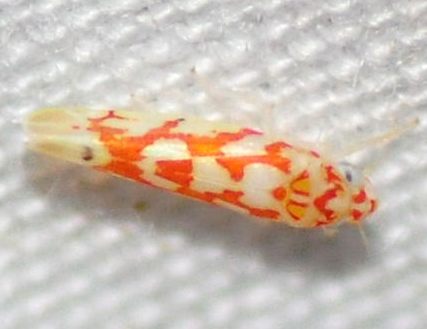| Comment: This page serves as an umbrella for any individuals of Eratoneura that have a bold color pattern on the wings and body. Eratoneura can be a very challenging genus to identify, as most species are similarly colored and patterned. These species tend to have a dark orange to red M-shaped mark on the pronotum, bold submedial lines on the vertex, a scutellum with a dark apex and outlined lateral triangles, and wings with a thick color pattern. Below are the descriptions in the 3I database for the various Eratoneura in the eastern United States that have a bold color pattern. As you can see, both species are very similar to one another. NOTE: Records exist for some Eratoneura species in North Carolina, but these species are not easily identifiable and its unclear if these identifications are correct (sometimes they are not); therefore, these records have not been entered into the site.
E. carmini- Dorsum yellow or white. Color pattern red or orange. Vertex with orange parallel submedial lines (often with lateral branch). Vertex midline pale. Anteclypeus pale, concolorous with rest of face. Pronotum with Y- or V-shaped medial vitta. Mesonotum pale, with dark lateral triangles, apex dark, contrasting with adjacent pale areas. Thoracic venter entirely pale. Forewings with broken oblique vittae, without crossbands. Clavus with separate basal and distal vittae. Forewings with dark spot on costal margin. Forewing apical cell II without distal spot, inner apical cell with brown spot basally.
E. interna- Dorsum yellow or white. Color pattern red or orange. Vertex with orange parallel submedial lines (often with lateral branch). Vertex midline pale. Anteclypeus pale, concolorous with rest of face. Pronotum with Y- or V-shaped medial vitta. Mesonotum pale, with dark lateral triangles, apex dark, contrasting with adjacent pale areas. Thoracic venter entirely pale. Forewings with broken oblique vittae, without crossbands. Clavus with separate basal and distal vittae. Forewings with dark spot on costal margin. Forewing apical cell II without distal spot, inner apical cell with brown spot basally.
E. lucyae- Dorsum yellow or white. Color pattern red or orange. Vertex with orange parallel submedial lines (often with lateral branch). Vertex midline pale. Anteclypeus pale, concolorous with rest of face. Pronotum with Y- or V-shaped medial vitta. Mesonotum pale, with dark lateral triangles, apex dark, contrasting with adjacent pale areas. Thoracic venter entirely pale. Forewings with broken oblique vittae, without crossbands. Clavus with separate basal and distal vittae. Forewings with dark spot on costal margin. Forewing apical cell II without distal spot, inner apical cell with brown spot basally.
E. propria- Dorsum yellow or white. Color pattern red or orange. Vertex with orange parallel submedial lines (often with lateral branch). Vertex midline pale. Anteclypeus pale, concolorous with rest of face. Pronotum with Y- or V-shaped medial vitta. Mesonotum pale, with dark lateral triangles, apex dark, contrasting with adjacent pale areas. Thoracic venter entirely pale. Forewings with broken oblique vittae, without crossbands. Clavus with separate basal and distal vittae. Forewings with dark spot on costal margin. Forewing apical cell II without distal spot, inner apical cell with brown spot basally.
E. greeni- Dorsum yellow or white. Color pattern red or orange. Vertex with orange parallel submedial lines (often with lateral branch). Vertex midline pale. Anteclypeus pale, concolorous with rest of face. Pronotum with Y- or V-shaped medial vitta. Mesonotum pale, with dark lateral triangles, apex dark, contrasting with adjacent pale areas. Thoracic venter entirely pale. Forewings with broken oblique vittae, without crossbands. Clavus with separate basal and distal vittae. Forewings with dark spot on costal margin. Forewing apical cell II without distal spot, inner apical cell with brown spot basally.
.
Additionally, a couple other species included on this page are similar to some of the individuals listed above and, in some circumstances, could be included in the group here. These species are E. forfex and E. knullae, and their descriptions are listed below.
E. forfex- Dorsum yellow or white. Color pattern red or orange. Vertex with orange parallel submedial lines (often with lateral branch). Vertex midline pale. Anteclypeus pale, concolorous with rest of face. Pronotum with Y- or V-shaped medial vitta. Mesonotum pale, with dark lateral triangles, apex concolorous with rest of mesonotum. Thoracic venter entirely pale. Forewings with broken oblique vittae, without crossbands. Clavus with separate basal and distal vittae. Forewings with dark spot on costal margin. Forewing apical cell II without distal spot, inner apical cell with brown spot basally.
E. knullae- Dorsum yellow or white. Color pattern red or orange. Vertex with orange parallel submedial lines (often with lateral branch). Vertex midline pale. Anteclypeus pale, concolorous with rest of face. Pronotum with Y- or V-shaped medial vitta. Mesonotum pale, with dark lateral triangles, apex dark, contrasting with adjacent pale areas. Thoracic venter entirely pale. Forewings with broken oblique vittae, without crossbands. Clavus with separate basal and distal vittae. Forewings with dark spot on costal margin. Forewing apical cell II without distal spot, inner apical cell with brown spot basally. |

 »
»




 »
»


